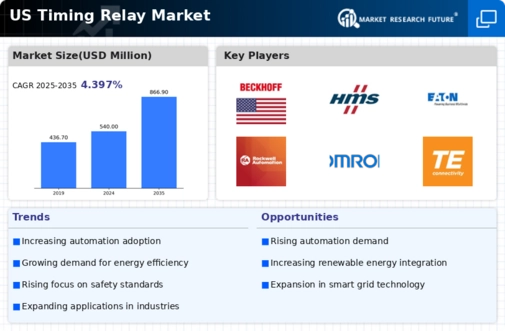Expansion of the Automotive Sector
The timing relay market is benefiting from the expansion of the automotive sector, which is increasingly incorporating advanced electronic systems. Modern vehicles require precise timing mechanisms for various functions, including engine management, lighting, and safety features. The automotive industry in the US is projected to grow at a CAGR of around 4% over the next few years, which will likely boost the demand for timing relays. As electric and hybrid vehicles gain popularity, the need for sophisticated timing solutions becomes even more critical. This trend indicates a promising future for the timing relay market, as automotive manufacturers seek to enhance vehicle performance and safety through advanced timing technologies.
Increased Focus on Safety Regulations
The timing relay market is also shaped by an increased focus on safety regulations across various industries. Regulatory bodies are implementing stringent safety standards to minimize risks associated with machinery and electrical systems. Timing relays are critical components in safety circuits, ensuring that equipment operates within safe parameters. The market is expected to witness a growth rate of approximately 5% annually as industries prioritize compliance with safety regulations. This trend is particularly prominent in sectors such as manufacturing, automotive, and construction, where the failure of safety systems can lead to severe consequences. As companies invest in safety upgrades, the demand for reliable timing relays is likely to increase, thereby driving growth in the timing relay market.
Technological Advancements in Automation
The timing relay market is experiencing a surge due to rapid technological advancements in automation. Industries are increasingly adopting automated systems to enhance operational efficiency and reduce human error. This shift is particularly evident in manufacturing and process control sectors, where timing relays play a crucial role in controlling machinery and processes. The market is projected to grow at a CAGR of approximately 6.5% from 2025 to 2030, driven by the need for precise timing in automated applications. As companies invest in smart manufacturing technologies, the demand for reliable timing relays is expected to rise, thereby propelling the timing relay market forward. Furthermore, the integration of Internet of Things (IoT) capabilities into timing relays is likely to enhance their functionality, making them indispensable in modern industrial applications.
Rising Industrialization and Urbanization
The timing relay market is poised for growth due to rising industrialization and urbanization in the US. As urban areas expand, there is an increasing demand for efficient infrastructure and industrial processes. Timing relays are integral to various applications, including traffic management systems, HVAC controls, and industrial automation. The industrial sector is expected to grow at a rate of approximately 3.5% annually, driven by the need for improved operational efficiency and reduced downtime. This trend suggests that the timing relay market will benefit from the ongoing industrial developments, as more companies seek to implement reliable timing solutions to enhance productivity and streamline operations.
Growing Demand for Renewable Energy Solutions
The timing relay market is significantly influenced by the growing demand for renewable energy solutions. As the US transitions towards sustainable energy sources, the need for efficient energy management systems becomes paramount. Timing relays are essential in solar and wind energy applications, where they help optimize energy production and consumption. The renewable energy sector is projected to expand at a CAGR of around 8% over the next five years, creating substantial opportunities for the timing relay market. This growth is driven by government incentives and policies aimed at promoting clean energy, which in turn increases the adoption of timing relays in energy management systems. Consequently, the timing relay market is likely to benefit from this trend as more industries seek to integrate renewable energy solutions into their operations.


























Leave a Comment